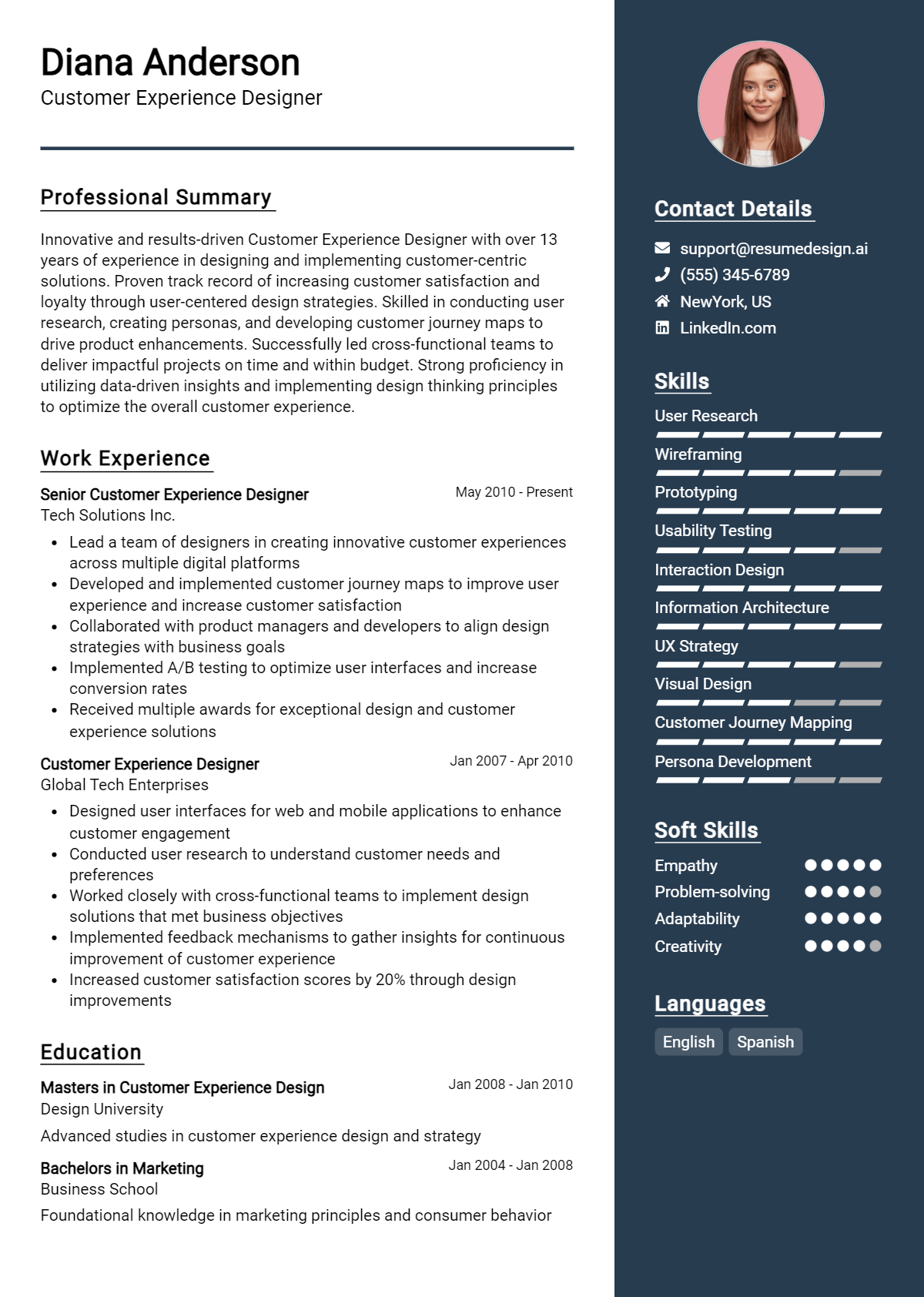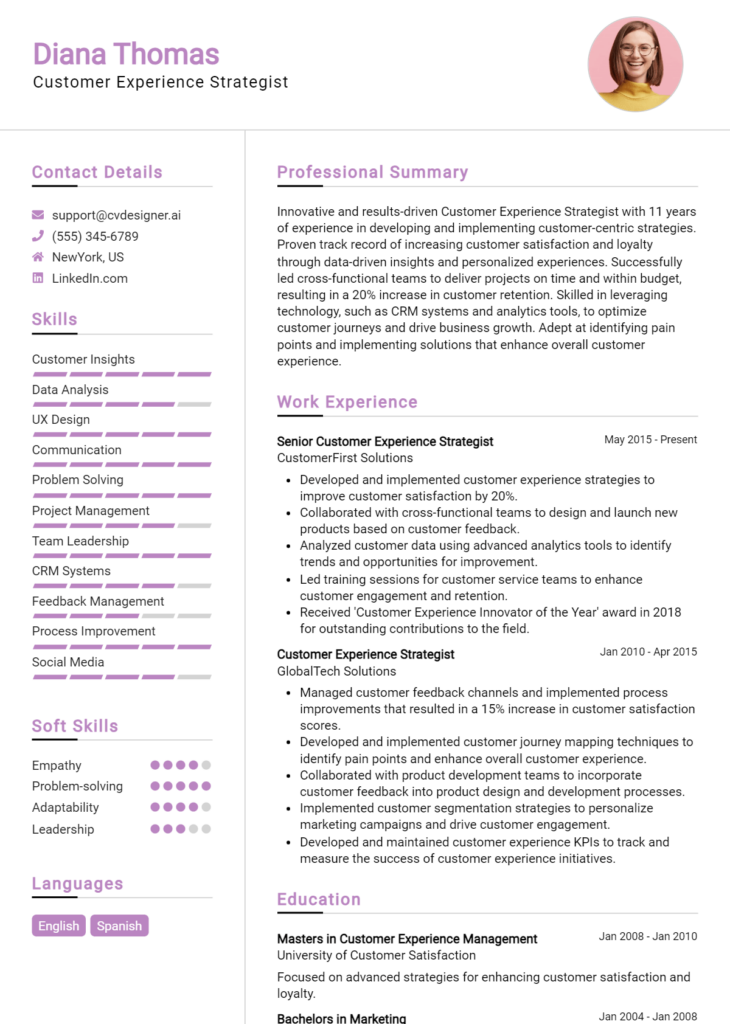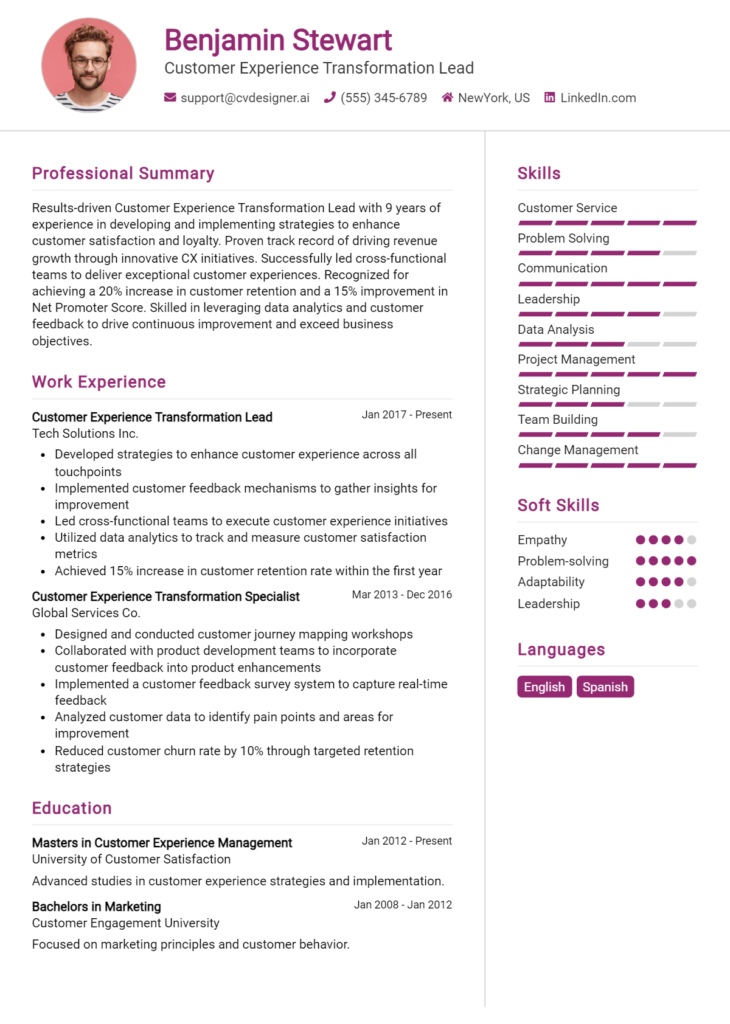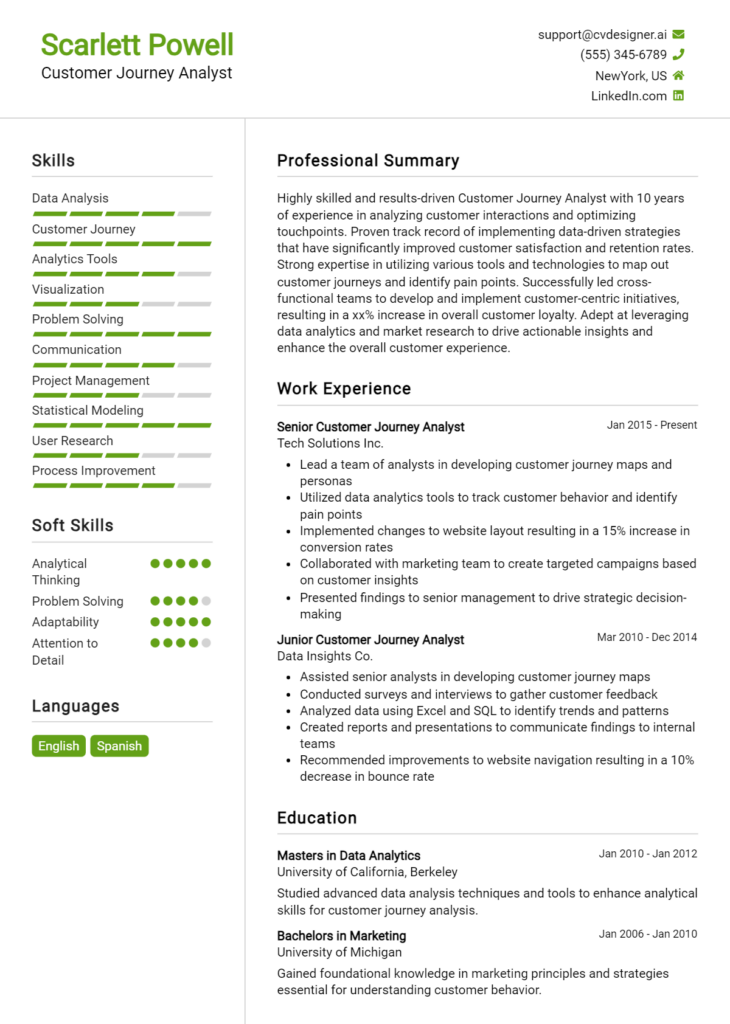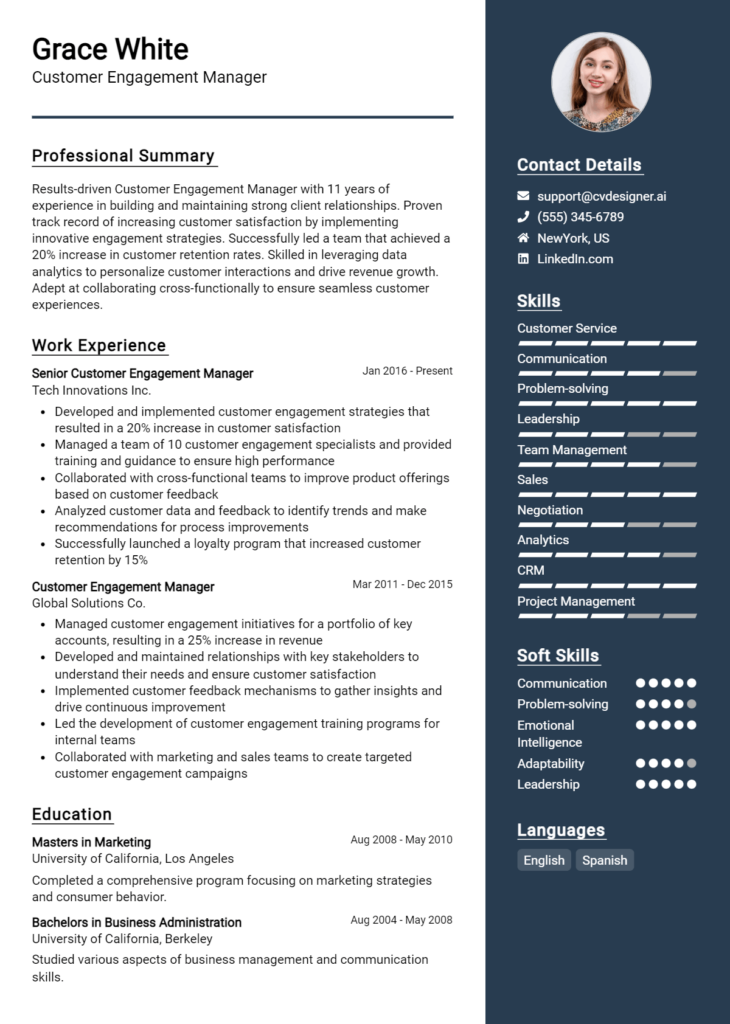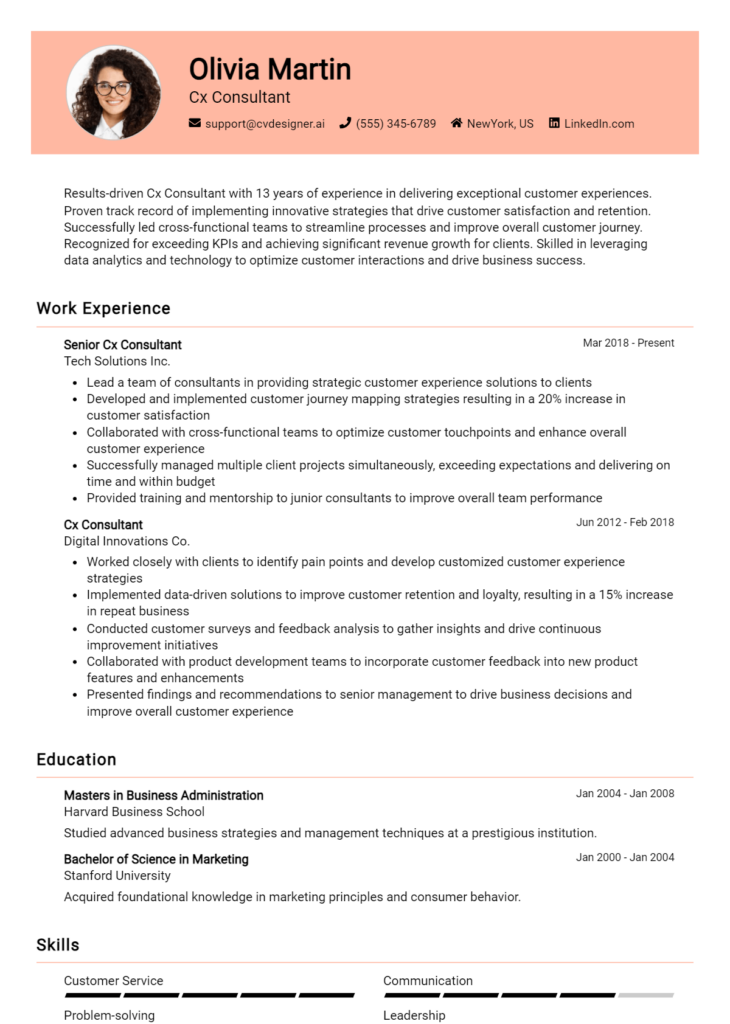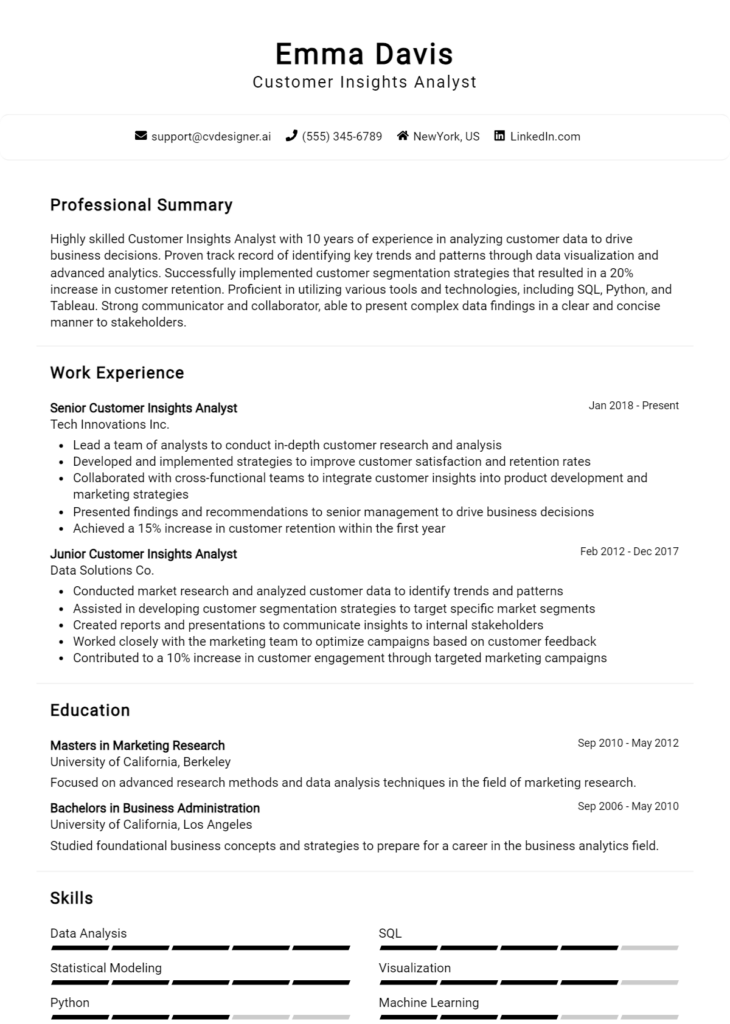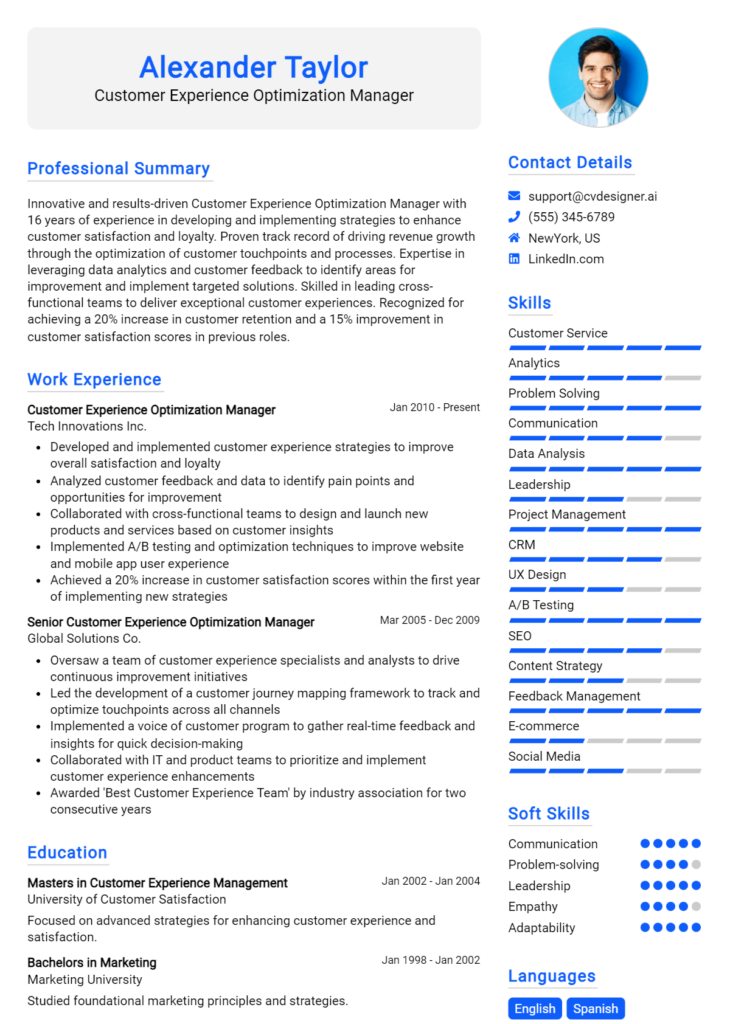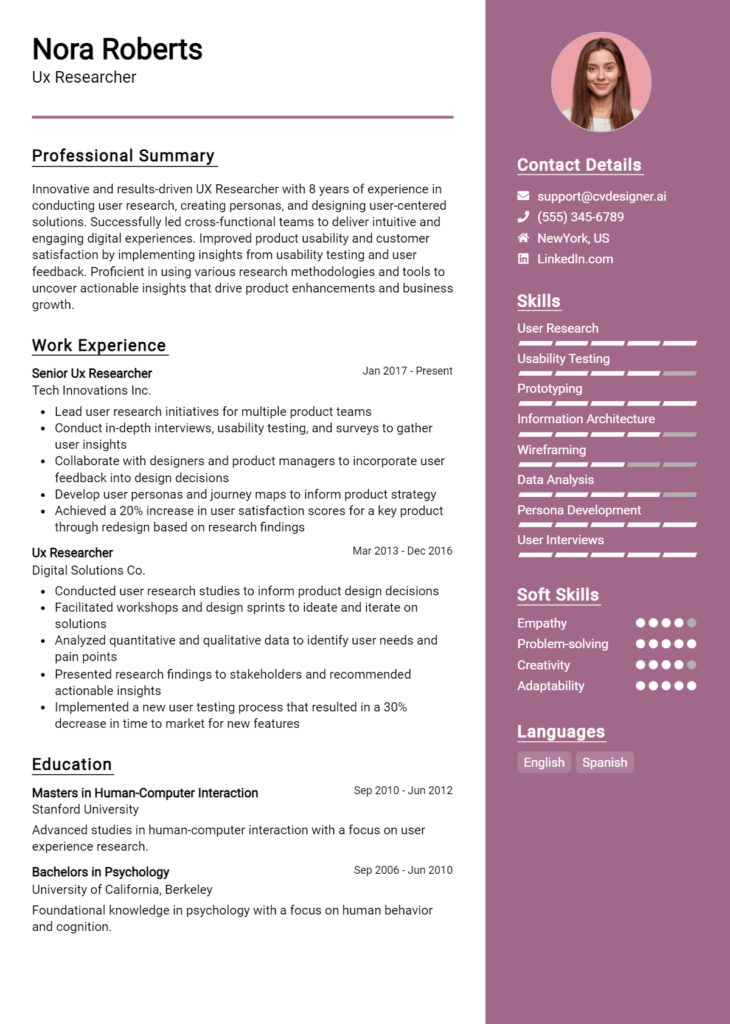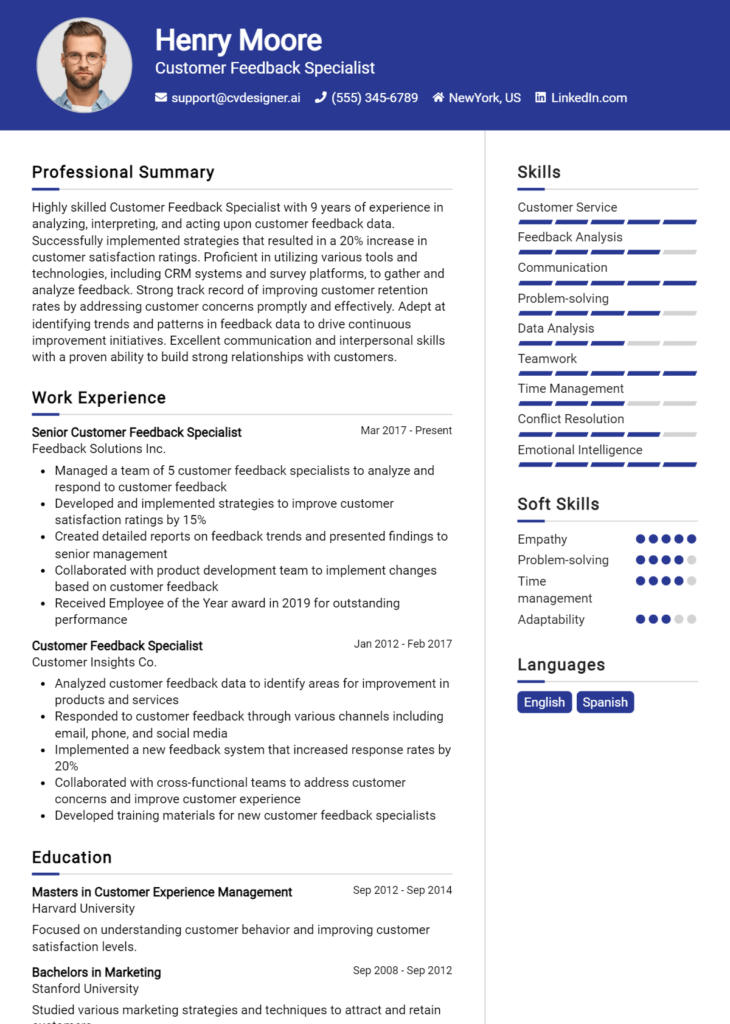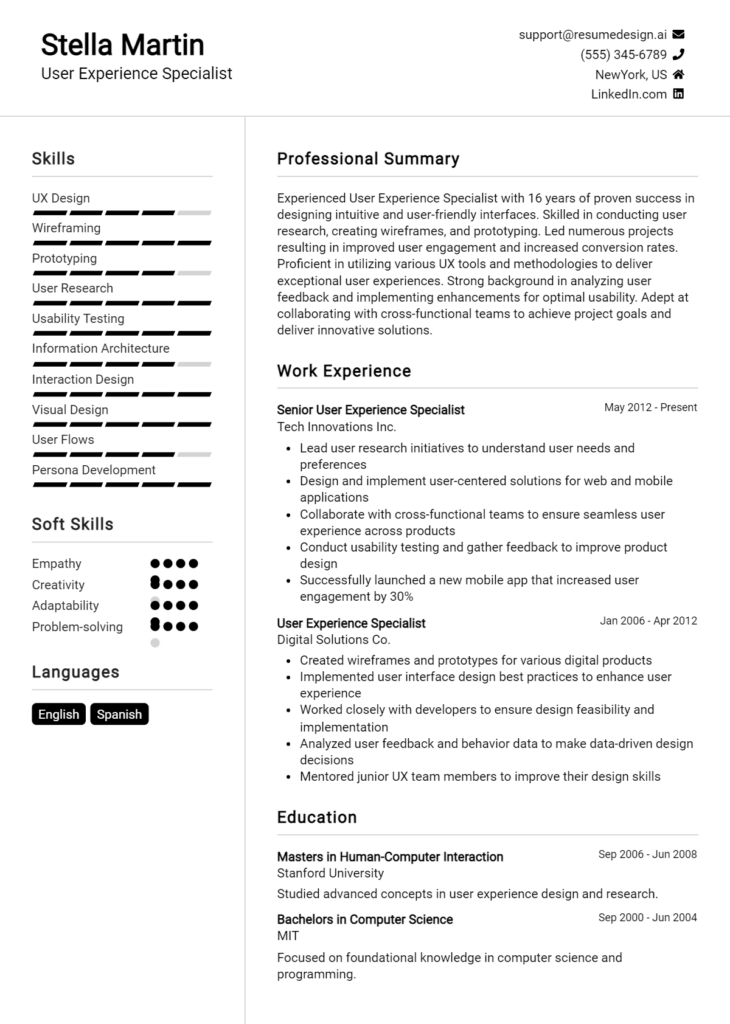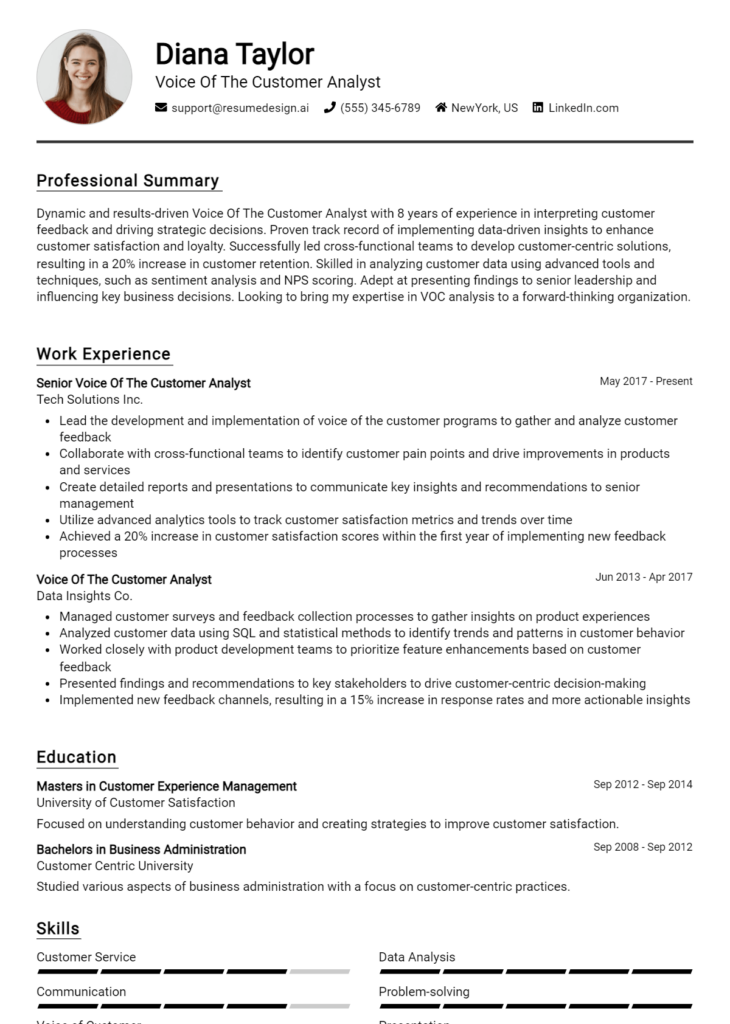Customer Experience Designer Core Responsibilities
A Customer Experience Designer plays a pivotal role in enhancing the user journey by collaborating across various departments, such as marketing, product development, and customer support. Key responsibilities include conducting user research, developing customer journey maps, and designing intuitive interfaces. Essential skills encompass technical proficiency in design tools, operational insight to streamline processes, and strong problem-solving abilities to address customer pain points. These competencies are crucial for achieving organizational objectives, and a well-structured resume can effectively highlight these qualifications to potential employers.
Common Responsibilities Listed on Customer Experience Designer Resume
- Conducting user research and usability testing to gather insights.
- Creating customer journey maps to identify pain points and opportunities.
- Collaborating with cross-functional teams to align design initiatives.
- Designing wireframes, prototypes, and user interfaces for digital products.
- Analyzing customer feedback to inform design improvements.
- Implementing design thinking methodologies to solve complex problems.
- Developing style guides and design systems for consistency.
- Facilitating workshops and brainstorming sessions with stakeholders.
- Monitoring industry trends to innovate customer experiences.
- Measuring the impact of design changes on customer satisfaction.
- Presenting design concepts and strategies to management.
- Ensuring compliance with accessibility standards in designs.
High-Level Resume Tips for Customer Experience Designer Professionals
In today's competitive job market, a well-crafted resume is crucial for Customer Experience Designer professionals looking to make a lasting impression on potential employers. Your resume serves as the first point of contact, and it must effectively reflect your unique skills and achievements in the realm of customer experience. A strong resume not only showcases your qualifications but also tells the story of your career journey, demonstrating how you can elevate user interactions and drive customer satisfaction. This guide will provide practical and actionable resume tips specifically tailored for Customer Experience Designer professionals, ensuring you present yourself as the ideal candidate.
Top Resume Tips for Customer Experience Designer Professionals
- Tailor your resume to the specific job description by including relevant keywords and phrases that align with the role.
- Highlight your experience in understanding user needs and designing solutions that enhance customer satisfaction.
- Quantify your achievements, such as increasing customer retention rates or improving user satisfaction scores, to demonstrate your impact.
- Showcase your proficiency with industry-specific tools and methodologies, such as user journey mapping or usability testing.
- Include a portfolio link to showcase your design work and case studies that exemplify your problem-solving abilities.
- Emphasize collaboration and communication skills, as these are essential for working with cross-functional teams.
- Utilize a clean and modern layout that reflects your design sensibility while ensuring readability and clarity.
- Incorporate feedback and results from user testing to demonstrate your commitment to continuous improvement in customer experience.
- List certifications or professional development courses related to customer experience design to highlight your dedication to the field.
By implementing these tips, you can significantly enhance your resume and increase your chances of landing a job in the Customer Experience Designer field. A well-structured and targeted resume not only captures the attention of hiring managers but also positions you as a strong contender for roles that require a deep understanding of customer needs and design thinking.
Why Resume Headlines & Titles are Important for Customer Experience Designer
In the competitive field of customer experience design, crafting a strong resume headline or title is crucial for making a memorable first impression. A well-thought-out headline immediately captures the attention of hiring managers, providing them with a succinct overview of a candidate's primary qualifications and unique value proposition. This brief yet impactful phrase should encapsulate the essence of the applicant’s professional identity, aligning closely with the specific role they are targeting. By being concise and relevant, a compelling headline can significantly enhance the chances of standing out among numerous applicants.
Best Practices for Crafting Resume Headlines for Customer Experience Designer
- Keep it concise: Aim for a headline that is no more than 10-12 words.
- Be role-specific: Use terminology that directly relates to customer experience design.
- Highlight key skills: Incorporate relevant skills that are in demand for the role.
- Showcase accomplishments: If possible, include a notable achievement or metric.
- Use action-oriented language: Start with strong action verbs to convey dynamism.
- Tailor for the job: Customize the headline for each application to suit the specific role.
- Avoid jargon: Use clear language that is easily understood by hiring managers.
- Reflect your personal brand: Ensure the headline aligns with your professional identity and values.
Example Resume Headlines for Customer Experience Designer
Strong Resume Headlines
"User-Centric Customer Experience Designer with 5+ Years in UX/UI Innovation"
“Empathetic Customer Experience Strategist Driving Engagement through Design Excellence”
“Data-Driven Designer Enhancing Customer Journeys with Insightful Solutions”
Weak Resume Headlines
“Looking for a Job in Design”
“Experienced Professional”
The strong headlines are effective because they immediately communicate the candidate's expertise and value in the context of customer experience design, using specific terms that resonate with hiring managers. They not only highlight relevant skills and experience but also convey a sense of purpose and direction. In contrast, the weak headlines lack specificity and fail to capture interest; they are too generic and do not provide any meaningful insights into the candidate’s qualifications or what makes them a fitting choice for the role. Strong, well-crafted headlines can set the tone for the entire resume and significantly improve the likelihood of securing an interview.
Writing an Exceptional Customer Experience Designer Resume Summary
A well-crafted resume summary for a Customer Experience Designer is crucial in distinguishing yourself in a competitive job market. It serves as a powerful tool to quickly capture the attention of hiring managers by succinctly showcasing your key skills, relevant experience, and notable accomplishments. A strong summary should be concise yet impactful, conveying your unique value proposition tailored specifically to the job you are applying for. This initial snapshot of your qualifications not only sets the tone for the rest of your resume but also motivates potential employers to delve deeper into your application.
Best Practices for Writing a Customer Experience Designer Resume Summary
- Quantify achievements: Use specific metrics to demonstrate your impact, such as increasing customer satisfaction scores or reducing churn rates.
- Focus on relevant skills: Highlight skills that directly relate to the job description, such as user research, design thinking, or journey mapping.
- Tailor your summary: Customize your summary for each job application to reflect the specific requirements and language of the job description.
- Use action verbs: Start sentences with strong action verbs to convey your proactive approach and achievements.
- Keep it concise: Aim for 2-4 sentences that convey your experience, skills, and value without overwhelming the reader.
- Showcase your passion: Highlight your commitment to enhancing customer experiences and your enthusiasm for the role.
- Avoid jargon: Use clear and accessible language to ensure your summary is understandable to a wide range of readers.
Example Customer Experience Designer Resume Summaries
Strong Resume Summaries
Dynamic Customer Experience Designer with over 5 years of experience in creating user-centered designs that increased customer satisfaction by 30%. Proven track record of leveraging user research and journey mapping to enhance product usability and drive engagement.
Results-oriented Customer Experience Designer with a focus on data-driven design strategies. Successfully led a cross-functional team that reduced customer service response time by 40%, improving overall customer satisfaction scores by 25%.
Innovative Customer Experience Designer adept at transforming complex user feedback into actionable design solutions. Increased net promoter scores by 15% through targeted UX enhancements and streamlined customer onboarding processes.
Weak Resume Summaries
Experienced designer with a background in customer experience. I have worked on various projects and have some skills that could be useful.
Customer Experience Designer looking for new opportunities. I enjoy working with customers and improving their experiences.
The strong resume summaries effectively highlight quantifiable results, relevant skills, and a direct alignment with the Customer Experience Designer role, making them compelling and impactful. In contrast, the weak summaries are vague, lack specific accomplishments, and fail to convey any significant value, rendering them less effective in capturing the attention of hiring managers.
Work Experience Section for Customer Experience Designer Resume
The work experience section of a Customer Experience Designer resume is vital in demonstrating a candidate's ability to enhance user satisfaction and streamline product offerings. This section not only highlights the technical skills necessary for crafting compelling customer journeys but also illustrates the candidate's proficiency in managing teams and delivering high-quality products. By quantifying achievements and aligning experiences with industry standards, candidates can effectively convey their impact on organizational success and their readiness to elevate customer experiences in future roles.
Best Practices for Customer Experience Designer Work Experience
- Highlight specific technical skills relevant to customer experience design, such as UX/UI design, user research, and data analysis.
- Quantify achievements by using metrics, such as increased customer satisfaction scores or reduced churn rates.
- Emphasize collaboration with cross-functional teams, showcasing your ability to work with product managers, developers, and marketing teams.
- Include relevant tools and technologies used in previous roles, such as design software or project management platforms.
- Demonstrate leadership by detailing experiences managing projects or mentoring junior team members.
- Align your experiences with industry standards and trends to show your awareness of the current market landscape.
- Use action verbs to convey initiative and effectiveness in your role.
- Tailor descriptions to reflect the specific needs of the job you are applying for, ensuring relevance and impact.
Example Work Experiences for Customer Experience Designer
Strong Experiences
- Led a cross-functional team in a redesign project that increased user engagement by 30% within six months, utilizing A/B testing and user feedback.
- Implemented a customer feedback system that resulted in a 25% improvement in Net Promoter Score (NPS) over one year.
- Developed and executed a customer journey mapping initiative that streamlined processes, reducing customer support tickets by 40%.
- Collaborated with software developers to integrate a new user interface that enhanced usability and decreased bounce rates by 15%.
Weak Experiences
- Worked on various customer experience projects without specific details on outcomes or contributions.
- Assisted in team meetings and discussions related to customer experience design.
- Participated in customer feedback collection without explaining how it impacted the design process.
- Implemented changes to the website with no mention of user testing or measurable improvements.
The examples provided highlight the difference between strong and weak experiences in the context of a Customer Experience Designer resume. Strong experiences are characterized by measurable outcomes, specific technical contributions, and clear collaboration with teams, showcasing the candidate's impact and leadership. In contrast, weak experiences lack detail, quantifiable results, and fail to illustrate the candidate's role or effectiveness in improving customer experiences, rendering them less compelling to potential employers.
Education and Certifications Section for Customer Experience Designer Resume
The education and certifications section of a Customer Experience Designer resume is crucial as it showcases the candidate's academic credentials and commitment to professional development in a competitive field. This section not only highlights relevant degrees and certifications but also emphasizes the candidate's dedication to continuous learning and staying abreast of industry trends and best practices. By including pertinent coursework, specialized training, and recognized certifications, candidates can significantly enhance their credibility and demonstrate their alignment with the job role, making them more attractive to potential employers.
Best Practices for Customer Experience Designer Education and Certifications
- Include degrees in relevant fields such as Design, Human-Computer Interaction, or Psychology.
- Highlight industry-recognized certifications, such as Certified User Experience Professional (CUXP) or Certified Customer Experience Professional (CCEP).
- Provide details of relevant coursework that aligns with customer experience methodologies and practices.
- List any specialized training or workshops that focus on tools and techniques used in customer experience design.
- Keep the information up-to-date and ensure it reflects your most recent qualifications.
- Use clear formatting to distinguish between degrees, certifications, and training for easy readability.
- Tailor the education and certifications section to match the specific requirements of the job you are applying for.
- Consider including online courses or MOOCs that demonstrate ongoing learning and adaptability.
Example Education and Certifications for Customer Experience Designer
Strong Examples
- Bachelor of Arts in Graphic Design, University of California, 2017
- Certified User Experience Professional (CUXP), Interaction Design Foundation, 2021
- Advanced Course in Customer Journey Mapping, Nielsen Norman Group, 2022
- Master's Degree in Human-Computer Interaction, Stanford University, 2020
Weak Examples
- Associate Degree in General Studies, Community College, 2015
- Certification in Basic Computer Skills, Online Learning Platform, 2019
- High School Diploma, Anytown High School, 2014
- Outdated Certification in Microsoft Office Suite, 2010
The strong examples are considered effective because they directly relate to the skills and knowledge required for a Customer Experience Designer, showcasing advanced education and recognized certifications that indicate expertise in the field. Conversely, the weak examples lack relevance and do not demonstrate the candidate's qualifications in customer experience design, which could lead to a perception of unpreparedness or a lack of commitment to professional growth in this specialized area.
Top Skills & Keywords for Customer Experience Designer Resume
A well-crafted resume is crucial for a Customer Experience Designer, as it serves as the first impression for potential employers. Highlighting the right skills can showcase your expertise in creating engaging and user-centric experiences. The skills you include not only demonstrate your qualifications but also reflect your understanding of customer needs and your ability to translate those into effective design solutions. By effectively showcasing both hard and soft skills, you can position yourself as a strong candidate who can contribute significantly to enhancing customer satisfaction and loyalty.
Top Hard & Soft Skills for Customer Experience Designer
Soft Skills
- Empathy
- Communication
- Collaboration
- Problem-solving
- Adaptability
- Critical thinking
- Creativity
- Attention to detail
- Time management
- User advocacy
- Active listening
- Conflict resolution
- Emotional intelligence
- Interpersonal skills
- Open-mindedness
Hard Skills
- User Research
- Wireframing
- Prototyping
- User Journey Mapping
- Usability Testing
- Interaction Design
- Visual Design
- Information Architecture
- Data Analysis
- Familiarity with Design Tools (e.g., Sketch, Adobe XD, Figma)
- HTML/CSS Basics
- A/B Testing
- Accessibility Standards
- Customer Feedback Analysis
- Agile Methodologies
For a comprehensive overview of how to effectively incorporate these skills into your resume, and to ensure that your work experience complements your skills, consider tailoring each section to align with the job requirements you're targeting.
Stand Out with a Winning Customer Experience Designer Cover Letter
I am excited to apply for the Customer Experience Designer position at [Company Name], as I am passionate about creating exceptional customer journeys that not only meet but exceed user expectations. With over [X years] of experience in user-centered design and a strong background in both qualitative and quantitative research methods, I am confident in my ability to contribute to your team and help elevate the customer experience. My expertise in designing intuitive interfaces and crafting seamless interactions has consistently resulted in higher user satisfaction and engagement.
At my previous position with [Previous Company Name], I led a cross-functional team in redesigning the customer onboarding process. By employing user personas and journey mapping, we identified pain points and implemented targeted solutions that reduced onboarding time by 30% and increased customer retention rates by 20%. I believe that understanding the voice of the customer is paramount, and I regularly gather feedback through surveys and usability testing to refine designs and ensure they resonate with the target audience.
I am particularly drawn to [Company Name] because of its commitment to innovation and customer-centric values. I admire the way your team integrates feedback into product development and continuously seeks to improve user experiences. I am eager to bring my skills in design thinking and empathy-driven design to your organization. I am confident that my dedication to fostering a positive customer experience aligns perfectly with your mission, and I look forward to the opportunity to contribute to your success.
Thank you for considering my application. I am excited about the chance to discuss how my background in customer experience design can add value to [Company Name]. I am looking forward to the opportunity to speak with you and explore how we can work together to create outstanding experiences for your customers.
Common Mistakes to Avoid in a Customer Experience Designer Resume
When crafting a resume for a Customer Experience Designer position, it's crucial to present your skills and experiences effectively. However, many candidates make common mistakes that can undermine their chances of landing an interview. Understanding these pitfalls can help you create a compelling resume that highlights your qualifications and aligns with the expectations of potential employers. Here are some common mistakes to avoid:
Generic Objective Statement: Using a one-size-fits-all objective can make your resume seem unoriginal. Tailor your objective to reflect your passion for customer experience design and how you can add value to the specific company.
Ignoring Keywords: Failing to include relevant keywords from the job description can hurt your visibility, especially if the company uses applicant tracking systems. Ensure your resume contains industry-specific terms and skills that match the job.
Overloading with Jargon: While familiarity with industry terminology is important, overusing jargon can alienate readers. Aim for a balance that showcases your expertise without overwhelming the hiring manager.
Lack of Quantifiable Achievements: Simply listing duties performed in previous roles does not showcase your impact. Use quantifiable metrics to demonstrate your contributions, such as percentage increases in customer satisfaction or reduced churn rates.
Neglecting Design and Layout: A cluttered or poorly designed resume can be off-putting. Ensure your layout is clean and professional, using consistent formatting, headings, and spacing to enhance readability.
Inconsistent Tense Usage: Mixing past and present tense can confuse the reader. Use past tense for previous roles and present tense for your current position to maintain clarity and professionalism.
Omitting Soft Skills: Customer experience design requires strong interpersonal skills, yet many candidates focus solely on technical capabilities. Highlight soft skills such as empathy, communication, and collaboration to present a well-rounded profile.
Not Customizing for Each Application: Sending out the same resume for multiple applications can be detrimental. Tailor your resume for each role by emphasizing the most relevant experiences and skills specific to the job at hand.
Conclusion
As a Customer Experience Designer, your role is pivotal in shaping how customers interact with a brand. You need to possess a blend of creativity and analytical skills, ensuring that every touchpoint is optimized for user satisfaction. Key responsibilities include conducting user research, developing user personas, creating journey maps, and designing intuitive interfaces. Effective communication and collaboration with cross-functional teams are essential to ensure that customer insights are translated into actionable design solutions.
In light of these insights, it's crucial to regularly review and update your Customer Experience Designer resume. Highlight your skills in user-centered design, your ability to analyze customer feedback, and your experience with design tools. Remember, your resume is often the first impression you make on potential employers, and it should clearly reflect your expertise and achievements.
We encourage you to take advantage of the available resources to enhance your resume. Explore resume templates to find a layout that suits your style. Use the resume builder to create a polished document that showcases your skills effectively. Check out resume examples for inspiration and ideas on how to present your experience. Lastly, don’t overlook the importance of a compelling cover letter; utilize cover letter templates to draft a personalized introduction to your application.
Take action now—revamp your resume and position yourself as the ideal candidate in the competitive field of customer experience design!

